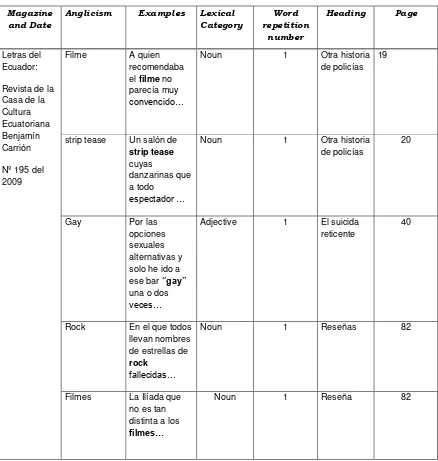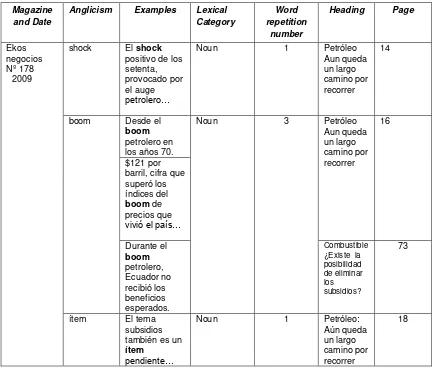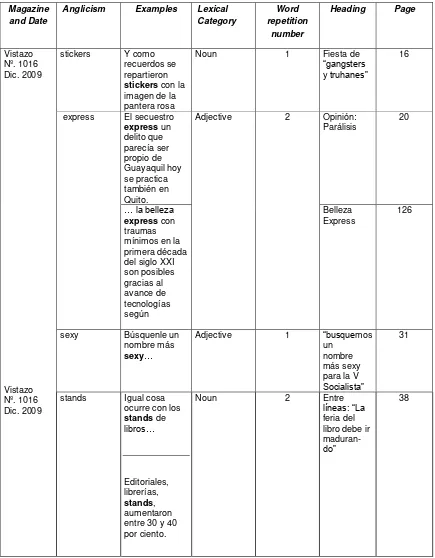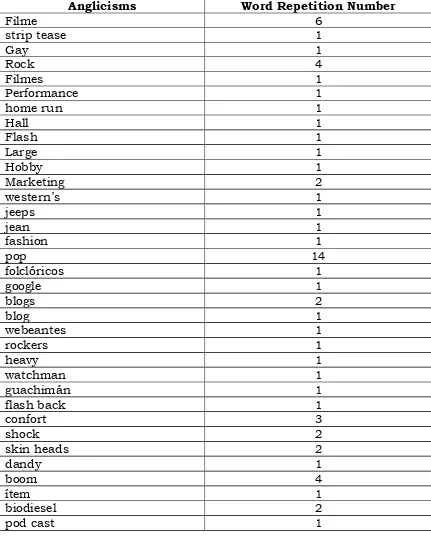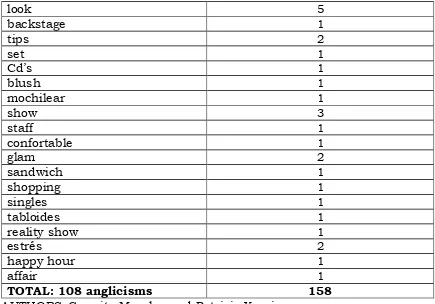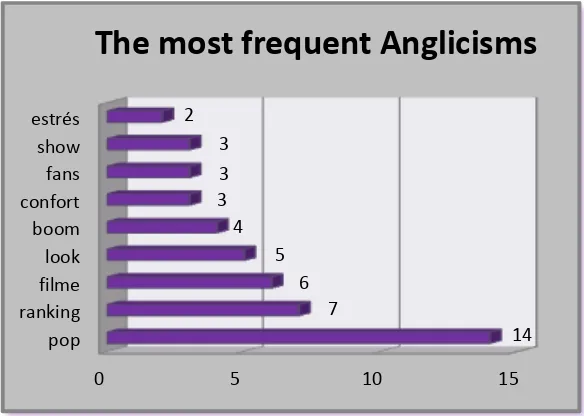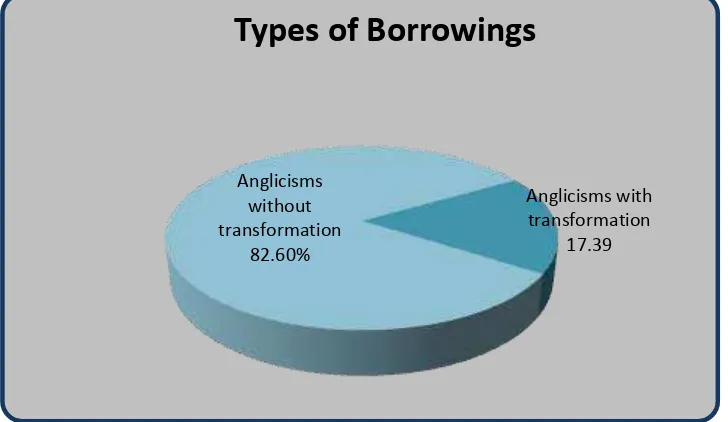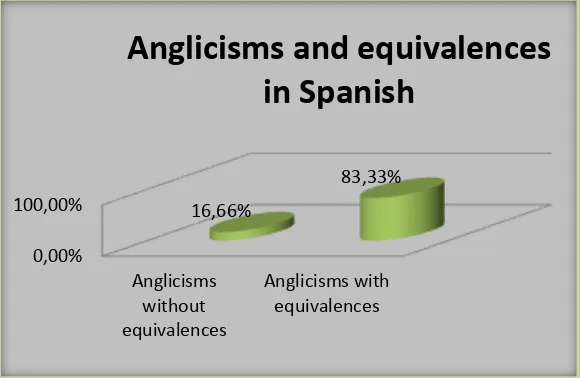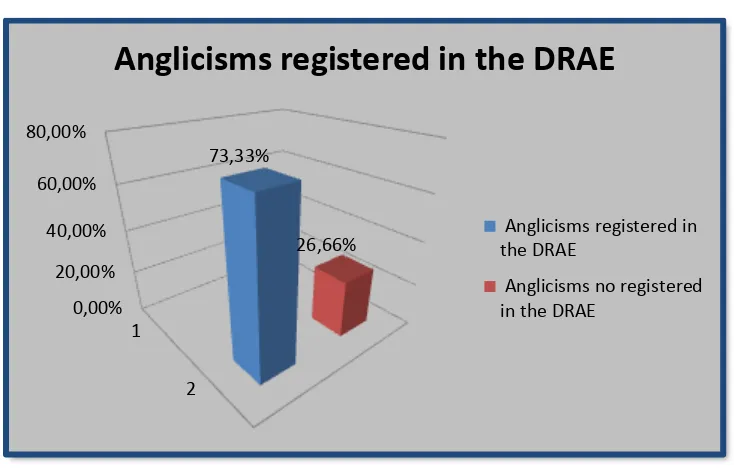UNIVERSIDAD TECNICA PARTICULAR DE LOJA
La Universidad Católica de Loja
ESCUELA DE CIENCIAS DE LA EDUCACIÓN MENCIÓN INGLES
MODALIDAD ABIERTA Y A DISTANCIA
A DESCRIPTIVE ANALYSIS OF ANGLICISMS
USED IN ECUADORIAN MAGAZINES
Research done in order to achieve the
Bachelor´s Degree in Teaching
English as a Foreign Language
AUTHORS
:
Carmita Romelia Morales Pilca
Patricia Tatiana Yumi Cevallos
ADVISOR
:
Lic. Daniela Holguín Barrera
CENTRO UNIVERSITARIO QUITO
Certification
Lic. Daniela Holguín Barrera
CERTIFIES THAT:
This research work has been thoroughly revised by the graduation committee. Therefore, authorizes the presentation of this thesis, which complies with all the norms and internal requirements of the Universidad Técnica Particular de Loja.
Loja, January 2, 2011.
………..
Lic. Daniela Holguín Barrera
THESIS ADVISOR
Contrato De Cesión De Derechos De Tesis De Grado
“Nosotras, Carmita Romelia Morales Pilca y Patricia Tatiana Yumi
Cevallos declaramos ser las autoras del presente trabajo y eximimos
expresamente a la Universidad Técnica Particular de Loja y a sus
representantes legales de posibles reclamos o acciones legales.
Adicionalmente declaramos conocer y aceptar la disposición del Art.67
del Estatuto Orgánico de la Universidad Técnica Particular de Loja que
en su parte pertinente textualmente dice: “formar parte del patrimonio
de la Universidad la propiedad intelectual de investigaciones, trabajos
científicos o técnicos y tesis de grado que se realicen a través, o que el
apoyo financiero, académico o institucional (operativo) de la
Universidad”.
……… ………..
Carmita Morales Patricia Yumi C.
AUTORA AUTORA
Authorship
The thoughts, ideas, opinions and the information obtained through this
research are the only responsibility of the authors.
Date: Quito, January 2, 2011
Carmita Romelia Morales Pilca Patricia Tatiana Yumi Cevallos
Author Author
Contents
Preliminary Pages
Certification i
Contrato de Cesión de Derechos ii
Authorship iii
Contents iv
Abstract 1
Introduction 2
Methodology 5
Discussion
Literature Review 7
Results 31
Description, Interpretation and Analysis of Results 56
Conclusions 108
References 110
Annexes
1
Abstract
The increasing number of anglicisms used everyday by printed
media in Spanish generated the idea to carry out the present paper,
which is a descriptive analysis of the anglicisms in Ecuadorian
magazines. This study was developed in Quito-Ecuador, and the
samples were taken from six magazines classified in three different
variables such as: cultural, scholarly and general interest.
The methods used for this investigation were the quantitative and
qualitative methods. Two phases were developed for the data collection,
the first one was bibliographical material about prior studies of
anglicisms; the second phase was gathering anglicisms found in the
Ecuadorian magazines which were classified and tabulated according to
the variable , frequency use, and types of anglicisms.
Regarding the results, the variable with more anglicisms was the
general interest magazines with 46, 29% of the total anglicisms because
this type of magazine broadcasts anglicisms constantly to be updated
with the globalized world to get more costumers.
Finally, the usage of anglicisms in Ecuadorian magazines has
increased in the last years, and the identity of Spanish and Ecuadorian
culture has been evolved and diversified even by incorporating
anglicisms in the linguistic system accepted in Spanish lexicon first by
speakers, and later by Real Academia de la Lengua Española (RAE)
2
Introduction
The growing influence of English in Spanish, as well as in other
languages, is basically expanded through the media and technology
which broadcast all kinds of English expressions quickly and easily. So,
the purpose of this study is to gather data related to anglicisms used in
Ecuadorian magazines, to identify these terms and analyze them in the
linguistic aspect.
This paper is a descriptive analysis of the anglicisms in
Ecuadorian magazines carried out in Quito-Ecuador, and its main
objectives are to research the linguistic phenomenon of these
anglicisms, to identify the most commonly used anglicisms in
Ecuadorian magazines, to make a deep analysis of them regarding the
syntactic, semantic and morphological aspects, and to establish which
variable contains the highest number of anglicisms.
Throughout this analysis, the phenomenon of anglicisms used in
Ecuadorian magazines and the process of their incorporation into
Spanish lexicon is because of the contact languages fact that shows the
lexicon of any receivable language is vulnerable and not a single
language could be an exception to this phenomenon.
The relevance of this research is to provide a descriptive insight of
the lexical interference of the English language into Spanish by
compiling the most frequent anglicisms used in Spanish within the
3
In order to carry out the research it was necessary to use the
quantitative and qualitative methods. The phases of this research were
first, a bibliographical data collection to gather prior studies of the use
anglicisms all over the world. Then, the anglicisms were taken out from
six Ecuadorian magazines classified in three types of variables: cultural,
scholarly and general interest magazines. The anglicisms found in the
magazines were listed and shown in tables to tabulate them according to
their frequency.
This process of gathering the anglicisms was developed by writing
down the whole sentence in which they occurred, and their frequency of
use. Finally, an analysis of thirty anglicisms was carried out taking into
account the syntactic, semantic, and morphological perspectives of each
one.
One of the most relevant prior studies is “Anglicisms in Europe:
Linguistic diversity in a global context” by Fischer (2008). This paper
was carried out in the United Kingdom and provided enough
bibliographical material of the use of anglicisms in different European
countries, and how the attitudes towards this phenomenon vary from
country to country.
Another important study related to this current research was
“Anglicismos en el Español Urbano de Salta” by Fernández (2001). Its
objective was to collect the level of English in four cities of the Northwest
4
through surveys via email. Therefore, this study is important as a
reference, because it is closely related to current research topic and it
provides some data of anglicisms used in some Latin American
countries, including Ecuador, and some factors that influence their
frequency in the Spanish language.
One of the most supporting studies was “Anglicismos en el
Lenguaje Quiteño” by Mera (1970) in which the researcher wanted to
look for the most used anglicisms in the Spanish language in the city of
Quito, using the descriptive method to gather anglicisms from the
media. In comparison to other Spanish speaking countries, Ecuador had
the lowest influence in their usage in the 1970’s.
The beneficiaries of this paper are UTPL, the two researchers who
carried it out, and people interested in Linguistics because this research
contributes with a deep analysis of anglicisms in Ecuadorian magazines
and it could be useful as a reference in the Linguistics field.
The current research has achieved the goals that were settled at
the beginning of this introduction, since it identified the most frequent
anglicisms in Ecuadorian magazines, the variable with the highest
number of repetitions, the possible causes for this phenomenon; and it
developed a descriptive analysis of thirty anglicisms according to the
syntactic, semantic and morphological perspectives and how these
5
Methodology
This paper was carried out in Quito, Ecuador, and for this study it
was necessary to gather data about anglicisms from six Ecuadorian
magazines, which were classified into three different variables: cultural,
scholarly and general interest magazines.
The techniques applied for this research were note taking and
reading, and the instruments used in this research were qualitative and
quantitative tables for tabulating the anglicisms, and statistical graphics
to demonstrate the results.
Regarding the sample, from all the anglicisms found in the
selected magazines grouped per variable, only thirty anglicisms were
selected to be analyzed and classified according to the different language
vices such as: borrowings, barbarisms, and loans using the syntactic,
semantic and morphological analysis.
The tabulation of data was analyzed taking into account the
anglicisms and their frequency of use, types, morphological changes,
function, registration in the Diccionario de la Real Academia de Lengua
Española (DRAE), and if there are equivalent words in Spanish. Finally,
a comparative analysis among the variables was developed.
Furthermore, when the field research was done, this information
was classified and organized into tables according to the variables, and
the results were presented in the same format. The methods used to
6
description, analysis and interpretation of the results, it was very
important to take into account the information of the Literature Review
presented in the next chapter, in order to give relevance, consistence,
and support to the basis of the paper as well as conceptual reference of
the current analysis.
Finally, at the end of the process, conclusions were settled to state
the results of the research and to summarize the contribution of this
analysis to the linguistic field.
7
DISCUSSION
Literature Review
The relevance of the present paper is to provide a descriptive
insight of the lexical interference of the English language into Spanish,
by compiling the most frequent anglicisms used in Spanish within the
printed media, in particular magazines. The Spanish language has been
influenced by other languages like Latin, French and Italian, and lately
by English. Rodriguez and Lilo’s study (1997, as cited in Delgado &
Hernández, 2001) showed that English has had more effect in Latin
America in the last decades of the 20th century through science,
technology, cinema, T.V., and music. In the same way, Rosenhouse and
Kowner´s study (2008, as cited in Domanska, 2009) said that due to
globalization and development, every living language needs to be
updated, and English is the mother tongue of some of the most
advanced and developed countries such as: Great Britain, the United
States, Canada, and Australia; therefore, English has become a donor
to other languages because of its use in business and technology, using
the Internet as one of the most frequent means of communication in a
globalized world.
Sometimes the international role of English is controversial. Fisher
(2008) stated “The increasing international influence of English has
8
appreciate its political, economic, and cultural advantages, others are
sensitive to a possible threat to other languages and cultures” (p. 4).
In addition Fischer (2008) concluded anglicisms take place in high
school and college levels of education with different frequency, since in
the adolescence stage, young people start to use technology and follow
tendencies from Anglo-Saxon countries. The incorporation of English
into other languages generates new words and expressions, as loans and
borrowings that often readjust the semantic aspect, displacing or
replacing local words.
As this study is focused on anglicisms that are part of Linguistics,
it is necessary to begin with its concept to introduce our topic in a
general view. And then, continue describing the general concepts of
branches of Linguistics, contact languages, types of language vices, and
magazines.
Linguistics is the scientific study about human language”
(Cardona, 1991, p. 172). Gimate (1994) says that Linguistics was
different in the past, but nowadays there is a strong integral tendency
giving a greater sense of Linguistics studies, since it is a socio-verbal
science.
Some branches of Linguistics are going to be described to identify
their relevance in this research study. These branches of Linguistics are
the following: Morphology, Semantics, Pragmatics, Phonology, and
9 “Morphology is concerned with the forms of words themselves […] it
is the study of the meaningful parts of words” (Malmkjær, 1991, p. 32).
This science will provide the root of the word and which transformation
the word has suffered when it was introduced into Spanish.
“Semantics is not only concerned with words as much, but also
figures at levels of language below the word and above it” (Widdowson,
2007, p. 53). This science will contribute to understand the meaning of
anglicisms in this research.
Pragmatics is “what people mean by the language they use, how
they actualize its meaning potential as a communicative resource”
(Widdowson, 2007, p. 61). In other words, this science studies the rules
and principles that govern a language and how they would be used in a
practical way.
Phonology according to Wardhaugh (1972) Phonology studies the
sounds in order to understand how they function and how small
differences in sounds convey different messages. This branch of the
Linguistics will provide a description of the meaningful sounds that
human beings produce. And in the case of the anglicisms that are
incorporated into Spanish sometimes these are used with a different
pronunciation than in English.
Syntax is “The inflectional attachments we have been talking about
can be seen as couple devices which allow words to function as
10
(Widdowson, 2007, p. 275). As Syntax is the study of the constituents
of the sentences and phrases in a language its relevance in this study is
to identify if the anglicisms are correctly used.
In the same way, going deeper into Syntax, the parts of the speech
are relevant within a sentence. It is also important to identify their
function in the sentence, and if the anglicisms suffered any variation
when they were introduced in the Spanish language. The parts of the
speech are the following: nouns, adjectives, verbs, and adverbs.
A noun is any member of a class of words that can be combined
with determiners functioning as the subject of a verb. It can be replaced
with a pronoun, and it refers on the same way to an entity, quality,
state, action, or concept. (Merriam-Webster Online Dictionary, 2010).
An adjective is “a word that describes or modifies a noun or a
pronoun”. (Qualls and Sánchez, 2008, p. XIII).
A verb is “a word that characteristically is the grammatical part
with a predicate and expresses an act, occurrence, or made of being”
(Merrian-Webster Online Dictionary, 2010).
An adverb is “a word that describes a verb, an adjective, or another
adverb” (Qualls and Sánchez, 2008, p. XIV). However, adverbs do not
change form to reflect gender and number, in most cases adverbs follow
the verb and precede the adjective in a sentence.
Contact languages, according to Hymes (1971) contact
11
or more languages, it has a rudimentary grammar and vocabulary, and
it is used for communication between groups speaking different
languages, and it is not spoken as a first or native language. In
addition, as all languages are dynamic and constantly in contact with
other languages, this produces a phenomenon of the appearance of
loans and adaptations of certain words in different cultures.
Language Vices stated by Fernández, B. (2008) “are inadequate
forms of construction or inadequate uses of vocabulary that can make
difficult the correct interpretation of writing” (p. 1). This inadequate
construction of vocabulary is due to contact languages issue. The
language vices are barbarisms, anglicisms, borrowings, and loans.
Barbarisms according to McArthur (1998) are a non-technical term
by combining elements from different languages, especially classical
with vernacular in an unsatisfactory way. And according to Cardona
(1991) they could be considered as a result of an incorrect way of using
when it is spoken due to the interference of the mother tongue. This
phenomenon of barbarisms is commonly used not only by people who
belong to low cultural level but also by high level people as writers, and
journalists. When barbarisms are used in a general way, sooner or later
they are going to be recognized by Real Academia de la Lengua Española
in the case of the Spanish Language.
Anglicisms also take part of the language vices, and people could
12
than an artificial invented word from Spanish. Sajavaara (1978) said
“Anglicisms are all those words which can be determined to have
English as their Language of origin or denote an object or a concept of
English origin” (p. 5).
Borrowing is another language vice that is readjusted in the
semantic space. Borrowings tend to be incorporated from the most
influential language to the other language. These borrowings are taken
from another language, adapting their primitive form, transforming
them somehow, sometimes displacing, and sometimes replacing local
words. López, (2005) said “Borrowing is the incorporation of a foreign
word into a language either with some phonetic alterations or not,
whose foreign origin (at least in the first step of incorporation) is clear to
a greater or lesser degree” (p. 95). The use of borrowings in the Spanish
Language is very common and for this research it is necessary to
identify the adapted words used in the Ecuadorian magazines, in order
to do a deeper analysis of the anglicisms.
Loan is another language vice that has more transformations in the
target language since it is a literal translation of one word from another
language. Sometimes there is a lack of sense in the translation. For
example, rasca cielos, saca corchos, toma corriente, etc. Domaska
(2009) stated “A calque is a special kind of borrowing whereby a
language borrows an expression from another, but then translates
13 Magazine according to Casatti (2006) comes from the denomination
“revista” in Spanish which means read again. The magazine in
comparison to the newspaper comes with unpublished news that is
more concentrated in the details of the present time. Magazines are very
relevant to our study because English is an international language and
there is a snobbish tendency to use this language frequently in this type
of printed media. It is important to mention that media promotes this
type of language to its readers. Furthermore, the most striking
phenomenon in the printed media is the influence of English, because it
is an international language phenomenon, and there is a tendency that
most journalists use English words in their discourse to arise the
audience’s attention. Nowadays, in the written media, anglicisms are
very often used, and in the specific case of Sim and Pop’s study (2009)
the most important target market in their study carried out in Rumania
was women over eighteen years old. Besides, the most present domains
were the musical domain, everyday life, fashion, sports and economics.
Prior Studies related to anglicisms are relevant to this study
because they provide the foundation to the literature review, and then to
the analysis of the present research. One of the prior studies found was
carried out by Fischer & Pulaczewska in 2008. This study was related
to anglicisms in Europe, in which some authors stated their findings
about anglicisms. The term anglicism was first used in the 17th century
14
word anglicism is not only connected to the English from England, but
also to English loans from all varieties of the English language.
One relevant aspect of this study could be that as any new word,
an anglicism may undergo certain phases of integration into a language.
This process could make the anglicisms become part of the common
lexicon of any language, properly recognized, and sometimes the
anglicisms will not be recognized.
Doval’s study (2005, as cited in Fischer & Pulaczewska, 2008)
analyzed that the history of the purification of German from
Anglo-Saxon influences in the late 19th and early 70’s, demonstrating a
historical continuity of fears regarding the English influence and
maintaining the purist language ideology as well as the effects on the
German language. In the same study, one fact is revealed even though it
has some opposition, and it is said that nowadays of all European
countries, it is France that is probably most widely heard as a site of
organized and institutional purism directed against the influx of
anglicisms. In contrast, Humbley’s study (1997, as cited in Fischer &
Pulaczewska, 2008) said the previous statement is questionable because
this view of French is less susceptible to Anglo-Saxon influence than
many other European languages.
According to Fischer (2008) modernization, globalization, and
15
to Anglophone values, which in turn, affect the choice of names given to
the newly-borns.
Regarding the reasons for using anglicisms, Hietaranta (2008, as
cited as in Ficher & Pulaczewska 2008) stated pragmatic factors, to use
anglicisms in his study about the influx of anglicisms in Finnish which
were technical and time savings in the process of translation.
Quantifying the impact of non-adopted anglicisms in Italian,
Cristiano Furiassi’s study (2008, as cited in Fischer & Pulaczewska,
2008) showed that even though the number of anglicisms in Italian
dictionaries is considerable, this fact was much lower in newspapers.
In Fischer’s study (2008) some observations were stated such as:
languages respond to the changes need of communication; anglicisms
concentrate on several main areas like printed media, dictionaries,
opinions about attitudes towards anglicisms and certain language
registers and technical languages. Gӧrlach’s study (2002, as cited in
Fischer & Pulaczewska, 2008) observed that the English technical terms
can often be attributed to the printed media, and the English
colloquialisms then occur in advertising, in journalism, and in youth
language.
In the same way, another important aspect of Fischer’s study was
when English words are integrated to another language, only one or a
couple of the individual English meanings are borrowed and the rest are
16
Pulaczewska, 2008) showed that anglicisms are indeed on the rise, but
foreignism of other languages through English seems unlikely. Fischer
(2008) concluded that the increasing international influence of English
has been welcomed by many speakers, but criticized by many others.
Moreover, Fischer stated anglicisms embody Anglophone or
American social and cultural structure and values. Therefore, English
is not perceived as a competitor language but as a communicative
language, and the attitude towards anglicisms seems different from
country to country.
Finally, according to Fischer (2008) the European Union applies its
motto of “Unity in diversity” which means that they respect and promote
the rich cultural and linguistic diversity of Europe to safeguard and to
enhance Europe’s cultural heritage.
There have been other prior studies about anglicisms in different
countries. For example, one was carried out by Domanska in 2009.
This study is related to the influence of English in the Norwegian
language used by young people because their mother tongue is changing
in an alarming way.
Among the most important data about Domanska’s study there
are the following statements:
This study examined if Norwegian students are aware of the
danger caused by frivolous borrowing of English words, and their
17
Moreover, the author used the method of observation where she
noted and created some judgments regarding anglicisms in everyday
language. The researcher used a small set of interviews, but the main
source of information was a questionnaire via email. The results
obtained were that the majority of participants did not have any
particular problem in communicating with foreigners, and they treated
anglicisms as part of Norwegian language. Regarding the attitudes of the
participants, Domanska found relaxed attitudes towards anglicisms and
they did not have anything against the English words coming into their
language mostly on the informal level among friends. Their language
and culture have been influenced to some extent by English films,
music, and magazines because young people want to be updated with
the young slang and culture. Furthermore, most Norwegian students
were very much aware of the intense usage of anglicisms in the
Norwegian language.
According to Domanska (2009) even though Norwegian students
did not pay much attention towards their mother tongue nor identify
themselves with it; they are still careful in the amount of anglicisms they
use. In addition, media in Norway tries to step in and inform people
about the possible damages that anglicisms could cause in the
Norwegian language. For this reason, an extensive usage of foreign
18
need to accept it, but at the same time they need to absorb and control
it.
Domanska’s study has great relevance to the present paper
because it refers to one of the most important target groups that use the
anglicisms around the world more frequently, which are teenagers and
young adults, confirming the worldwide phenomenon of anglicisms.
Another important prior study was carried out by Fernández in
2001. This author used the descriptive method, which described and
measured the phenomenon of anglicisms. The author also used an
analytical method where he recognized and showed the lack of academic
level of anglicisms in Argentina.
The sample of Fernández’ study was taken from people of different
socio-cultural levels, ages and educational backgrounds, and also from
different countries of Latin America and Spain via Internet.
Among the results obtained in this research the following groups
used the aglicisms more frequently: female informants and teenagers.
Regarding the educational background: the university level participants.
In addition, regarding the hometown factor: Argentinean people and this
was because the original place where the research was carried out was
the Province of Salta, Argentina.
From the sample taken via Internet, the most frequently used
anglicisms were ok, please, sexy, shopping, thank you, zapping,
19
The objective for carrying out Fernández’s research was to collect
the level of English in four cities of the Northwest of Argentina and in
some other countries in Latin America and Spain through surveys via
email.
Fernandez (2001) concluded that there was a sustainable
advancement of the anglicisms not only in Spanish Language but also in
other languages. Therefore, there was a technological contribution to the
English Language, and the Internet was a relevant means for
researching about this topic, whose sample was representative,
contrastive, and updated according to the informants.
Fernández’s study is important as reference because it is closely
related to the Descriptive analysis of the anglicisms in the Ecuadorian
magazines and this provides data about anglicisms used in some Latin
American countries including Ecuador, and some factors that influence
their frequency of use in the Spanish language.
Another important prior study found was Luján’s (1998). This
study was related to the influence of anglicisms in a specific place: the
Canary Islands, and how a great number of English words have been
introduced into Spanish.
This study used the descriptive and analytical methods, because it
described the phenomenon of the anglicisms and the attitudes towards
the Anglo-American Culture in the Canarian Islands through qualitative
20
In addition, the study was divided in two sections: the theoretical
and the practical analysis of four Canarian newspapers and two
Canarian television programs in which direct observation and note
taking were the techniques to collect the data. Most Canarians stated
that they preferred Americans rather than British because they are more
open and accessible than the British, but they preferred to speak British
English than American English. Besides, there was something special
to mention they did not were interested in adopting Anglo-American
culture.
As conclusions, Luján (1998) stated that most Canarians used
English words in their daily language; moreover, there was a positive
attitude towards the English language and the Anglo-American culture;
also, a great deal of population needed to master English for many
reasons, but they were aware of the influence over them as an invasion.
There is another important study of anglicisms that was carried out
in Quito by Mera (1970). In this study the researcher wanted to look for
the most used anglicisms in the Spanish Language in the city of Quito,
Ecuador. By using the descriptive method, the researcher wanted to do
an analysis of the anglicisms found in two newspapers, one radio station
and some TV programs in Quito. The media analyzed was the
newspapers “El Comercio” and “El Tiempo”, “Radio Quito”, and some TV
21
The words found in this research were the following: brassiere,
brandy, boycott, cake, candy, closet cocktail, chance, check, flash, film,
folklore, football, hit, magazine, night club, park, pijamas, ok, record,
standard, slogan, esmoquin, suéter, test, tique.
In 1970 the English influence in Ecuador was lower in comparison
to other Spanish speaking countries. However, Anglicisms were not
strange words for our lexicon, even some had been accepted by the Real
Academia de la Lengua; in contrast, other anglicisms had been used
because of the lack of the equivalent words in Spanish. Others had to
adapt to the Spanish grammar regulations; for example, word endings,
plural forms, syntax, and the appropriate use of gerunds, orthography
and pronunciation. Finally, according to Mera (1970), for English
teachers it is necessary to teach the original language of the words
besides the language itself.
It is important to highlight the relevance of Mera’s study because
the topic is very similar to the current paper, since it is a field of
investigation of the anglicisms in printed media, radio, and television.
Mera’s research could be considered as reference to this study since it
could compare the anglicisms of 1970 with the present time ones.
A similar research was carried out in Cuenca by Córdova (1991).
The results found by Córdova after an extensive research were 1481
22
addition, the repetitions of some English words in the border cities with
predominant political influence were outstanding.
Regarding the researcher’s analysis, each word had the following
aspects: the origin of the word, and its definition with several meanings
according to the researcher’s criterion.
As conclusions, Córdova (1991) stated that if there would not be
contribution from borrowings and contact languages, Spanish could be
isolated. For this reason, the linguistic borrowing is necessary to enrich
and foster any language because it is absurd to think in the isolation of
a language due to the extraordinary penetration of the modern mass
media.
Moreover, Cordova (1991) stated that the neologisms in a language
and the linguistic borrowing are relevant features of mutual sharing
among languages. Also, there are some appropriate and useful words,
but there are also useless and unnecessary words that are used in
everyday language.
The difference between Cordova’s study and the one performed by
Mera was the analysis of the words. Cordova’s study gathered as many
aglicisms as possible in a glossary found in media, conversations,
professional and street people, sings and labels. In contrast, the study
performed by Mera was an analysis of the anglicisms of Quito in some
23
As Cordova (1991) mentioned in his study, this one provides
bibliographical material for any linguistic research, mainly for the
analysis of each word.
Regarding studies of compilation of anglicisms, the one made by
Haensch (2008) presented a list of anglicisms frequently used in some
countries that stressed the differences between European and Spanish
American anglicisms. The author used a survey to consult linguists
about the differences between the Spanish of Latin America and Spain,
the rest of the information came from other lexical material like the
dictionaries published in the University of Ausburgo. The author did
not take into account those anglicisms that had the same meaning, but
only those ones that showed differences among the following areas:
different meanings, formal differences, changes about grammatical
categories and frequency in use.
The method this research used was the descriptive method with a
content analysis, as well as the observation of the anglicisms used in the
Hispanic countries and their dictionaries.
As results of Haensch’s study, there were the following: in
countries which had had less contact with the United States there was
more tendency to a graphical morphological adaptation and the Spanish
system, than in the countries with a strong American influence, such
as: the case of Mexico, the Caribbean Latin countries, Central America
24
In some countries there were anglicisms used with a different
meaning from others, and formed with Spanish elements. For example,
instead of sleeping, it is used “bolsa de dormir”, “saco de dormir”, “talego
de dormir”, etc. In the Spanish of America the nouns are common
names, for example: quaqueres instead of “copos de avena”, or scotch
instead of “cinta adhesiva”.
Finally, Haensch’s study (2008) concluded the anglicisms have
their own linguistic geography in the wide Hispanic world. Borrowings
and loanwords coming from English differ from country to country in
Latin America and Spain; and as limitations this study was only
performed among linguist informants from 19 countries, consequently,
the study did not include information gathered by common people from
these countries.
The phenomenon of the use of anglicisms in the printed media
and its influence in the Spanish of Latin America was developed in the
study made by Delgado and Hernández (2001). This study took place in
Costa Rica and the analyzed printed media was the newspaper “La
Nación”. The researchers classified the sections of the newspapers to
check the frequency of the anglicisms, taking into account the lexical,
morphological, syntactic, phonological and semantic criteria. The
section where most of the anglicisms appeared was “Revista Viva” with
45% of the total news; Sports had the second place with 23% and the
25
Among the most important points about this research there were
the following: within “Revista Viva” the sections with more frequent use
of anglicisms were show business and society. The ironical issue was
that in the International News section did not use as many anglicisms
as expected. In the show business section the majority of movies used
their original name in English, and there was also a tendency that the
names of Latin musical bands used English names. In the Sports
section the words used were calques or loanwords and they were
mispronounced. For example, the word “fault” in English is pronounced
“faul” in Spanish. Regarding one of the technological sections, the
lexicon used was so specific that the level of comprehension depended
on the reader and it was not written to everybody.
In the technology section there were the following words: ciber,
ciberspacio, cibernauta, ciberteca, etc. and according to Delgado and
Hernández (2001) some studies showed that more than 70% of the
Internet users are English speakers, that is the reason why
technological words are used as borrowings and loans. It is said that
the informatics manuals are written in “Spanglish” using calques or
loanwords. The most frequent anglicisms found in this newspaper were
the following: e-mail, videos, shock, fútbol, country, rap, computadores,
offshore, aplicar, round, super cross, set, minimizar, internet.
Delgado and Hernández (2001) concluded that some people might
26
comprehension interference between the writer and reader; however,
some others think their equivalent word in Spanish is not the same, and
the English word includes more meanings or it is more precise. With the
rise of technology, a great amount of English words with difficult
translation have been introduced into Spanish.
Another relevant conclusion Delgado and Hernández (2001)
observed was that even though journalists, linguists, and translators are
a small group, their responsible attitude against language could affect
the society directly. In the same way, excessive borrowings and
loanwords lead language and culture to the loss of identity. Because
Delgado and Hernández (2001) thought the current degeneration of
Spanish and neologisms are consequence of ease and laziness and they
could be avoided if some people assume the leadership to become aware
that language is a cultural heritage that should be protected.
Finally, Delgado and Hernández (2001) concluded that it is
important to acquire other languages, but this learning should not harm
our mother tongue towards the deformation of it.
It is important to mention that this study was so meaningful to
the present research topic since it is an analytical study of the printed
media in a Latin American country, Costa Rica. In addition, it provides a
real perspective of what is occurring in the media of other countries, the
27 Some prior studies about anglicisms were made about mass media.
For example, in the study carried out by Rábago (2008) in Baja
California, Arkansas and Mexico City, the author tried to identify and
explain the use of the new lexicon in the printed media with a relevant
circulation in border cities as a result of the introduction of this new
language and its cultural implications, and how well they were accepted
or rejected by the society. Consequently, as Rábago (2008) says this
phenomenon of lexicon exchange tends to stress socio-cultural
transformations and reflects the way that a language evolves, especially
if the newspapers transmit or promote the use of determined
vocabulary.
After reading Rábago’s study the following aspects were found: the
method used by the author was descriptive with content analysis of the
lexicon used in different newspapers; besides, Rábago’s study was
carried out with the help of direct observation and note taking research
techniques to gather data. The results of Rábago’s research were the
words and phrases without translation, the words that could be
translated, and the generated words by combination of elements of both
languages. In this third type of anglicisms were the ones with
adaptations and influenced by the “Spanglish” which were used by the
inhabitants from Baja California with people from California, for
example: “yonque” from English junk yard, “triqui-triqui” from trick or
28
level target market use more “Spanglish” words than newspapers with a
selected target market.
The majority of people who immigrated to the United States came
from low social level and they did not possess the necessary linguistic
tools to acquire a new language appropriately, as consequence
adaptations arise. For example, “wachar”, “mapear”, “liqueur”, etc. The
intense interaction between the people from both sides searches links to
ease communication.
Factors as the necessity of communication and the development of
links between languages make immigrant groups use “Spanglish”.
According to Avila’s study (2004, as cited in Rábago, 2008) language
should resist transformations to maintain good health, since language
transforms in relation to the reality its speakers live; but according to
Rábago (2008) perhaps the transformations in Spanish used in different
newspapers could come up with the official recognition of new terms
from English that enrich the Spanish language.
Finally, Rábago (2008) concluded that the transformations that
Spanish suffers go beyond the Spanish Language Academy regulations
in a smooth way, mainly when its culture is in contact with other
culture and accepts these transformations. It was difficult to analyze the
cultural implications of the use of anglicisms and borrowings that reflect
29
The great deal of anglicisms in Spanish language causes lexical
interference; therefore, López (2005) presents her paper, and this
provides a comparative insight into the semantic study of lexical
interference in English and Spanish within economics terminology field.
These adaptations also include borrowings, calques, and equivalents
causing changes in lexis. Gimeno’s study (2003, as cited in López, 2005)
stated that different lexical types according to category changes,
collocations and lexical calques are focused on social multilingualism;
for this reason, some researchers highlight their work on the influence
of English over Spanish studying the most common anglicisms, and the
process of incorporation into the language whose new words and
expressions are often unnecessary. Also Gimeno’s study (2003, as cited
in López, 2005) said the current influence of English upon Spanish
makes it difficult to establish when we are using a foreign word.
From Lopez’s study the most important obtained information was
that Rábago used the bibliographical method to gather information
about anglicisms, also the direct observation and a content analysis of
books, written news, internet pages, and mass media. Finally,
interviews and note taking were used as techniques.
As this is a compilation of prior studies of anglicisms, the following
data was collected in Rodriguez’s study (1997, as cited in López, 2005)
who highlighted the cultural influence among English and Spanish
30
study (2000, as cited in López, 2005) considers “foreignism” a word the
speakers perceive strange, either because of its spelling or by its limited
usage. And finally, Zuluaga’s study (2001, as cited in López, 2005)
described the equivalent relations in which translation is based;
therefore, equivalences are text units that do not always coincide with
their language system correspondences.
As conclusions, López (2005) stated that the Anglo-Saxon economic
supremacy together with its ever expanding market are also exporting
and increasing number of linguistic terms into other languages in the
economic field. In the same way, the rapid growth of economic
development makes borrowings necessary because there are no
semantic equivalences in Spanish, taking the strongest influence in
Marketing.
López’s research is relevant to the current paper because in the
economics field there is not enough translation into Spanish and these
new words have to maintain the English terminology. Besides,
economics magazines are going to be observed in our research and this
study will contribute to understand the globalization phenomenon from
31
Results
[image:36.612.108.546.186.647.2]QUALITATIVE TABULATION
Table One
Variable: Cultural magazine
Magazine and Date
Anglicism
Examples Lexical Category
Word repetition
number
Heading Page
Letras del Ecuador:
Revista de la Casa de la Cultura Ecuatoriana Benjamín Carrión
Nº 195 del 2009
Filme A quien
recomendaba el filme no parecía muy
convencido…
Noun 1 Otra historia
de policías 19
strip tease Un salón de
strip tease
cuyas
danzarinas que a todo
espectador …
Noun 1 Otra historia
de policías
20
Gay Por las
opciones sexuales alternativas y solo he ido a ese bar “gay” una o dos
veces…
Adjective 1 El suicida
reticente
40
Rock En el que todos llevan nombres de estrellas de
rock fallecidas…
Noun 1 Reseñas 82
Filmes La Ilíada que no es tan distinta a los filmes…
32 La Casa:
Revista de la
Casa de la Cultura Ecuatoriana Benjamín Carríon 66 Nº 2 2009
performance …un músico que desarrolle
su
performan-ce y que luego dialogue con los
asistentes…
Noun 1 Tierra
adentro en vivo.
5
home run …lanzar como Joe di Maggio lo hacía buscando el
home run.
Noun 1 Nuevos
libros.
6
Hall En el mismo
hall que recorrió todos los días camino al
despacho…
Noun 1 Aquí yace
un hombre bueno.
7
flash …con una
sonrisa espontánea y no de flash, con artistas y
pensadores…
Noun 1 Aquí yace
un hombre bueno.
7
large …algunos de
aquí y otros de afuera pero todos espíritus extra large.
Adjective 1 Aquí yace
un hombre bueno
7
hobby …la poesía
como institución como resurrección para hobby…
Noun 1 Crónica de
33 La Casa:
Revista de la
Casa de la Cultura Ecuatoriana Benjamín Carríon 66 Nº 2 2009
marketing …desde alguna oficina de marketing
al servicio de una postulante
a la Alcaldía…
Noun 2 La Casa
de Carrión organiza Núcleo de Pichincha 22-48 …dando
origen a la provechosa confluencia del
marketing y a la industria automotriz.
El premio mayor.
western’s Y ni hablar de los
innumerables y polvorientos western’s en que los apaches acosaban a la diligencia.
Noun 1 Tráfico en
las páginas
25
Jeeps …que no lo
conduciré borracho ni lo arrojaré contra los jeeps.
Noun 1 Tengo un
Ford Mustang
27
Jean Sería
imposible mantener una imagen de James Dean que construyó de joven y bello rebelde, sin su jean,
chompa de
cuero,…
Noun 1 El
escarabajo que se libró de la muerte.
30
fashion …Barnaby Jones hasta llegar a lo
fashion de Miami Vice.
Adjective 1 El
escarabajo que se libró de la muerte
34 Pop …un culto por
los objetos de consumo, pues el pop
celebra las cosas más
ordinarias…
Noun 4 Los
automóviles en las artes.
33-34
… pues tal
popular-dad fue lograda por el pop.
El pop
empleó los mismos elementos característicos … …vienen del pop porque incorpora una serie de elementos …
… pero los
artistas pop
no hicieron más que
Adjective 2 Los
automó-viles en las artes.
33-34
El automóvil también aparece en la pintura pop …
folclóricos Los diseños de los autos aparecen ,coloridos, glamorosos,
folclóricos y gigantescos
Adjective 1 Donde se
acaban los caminos.
36
google La biblioteca del siglo XXI, el infalible
muestra miles
de artículos….
Noun 1 Las
infracciones y las infractoras.
35 Blogs La biblioteca
del siglo XXI, el infalible Google, muestra miles de artículos, blogs,
estudios científicos, comentarios y fotografías.
Noun 2 Las
infracciones y las infractoras.
37-38
…curiosos blogs dan cuentas de miles de mujeres que mienten tener autos.
blog …..dice otra fémina en un
blog se realizó
un estudio…
Noun 1 Las
infracciones y las
infractoras
39
webeantes Al pie de los videos los curiosos
“webeantes”y los machos…
Noun 1 Las
infracciones y las
infractoras
38
Rock ….romance
que tiene la música, en especial el
rock y los
autos…
Noun 2 Estrella de
la carretera.
40-41
El rock en español de los años ochenta,
41
Rockers … hace poco partió al infierno de los
rockers…
Noun 1 41
heavy …tocando la guitarra para el grupo de heavy
inglés…
36
AUTHORS: Carmita Morales and Patricia Yumi
watchman … tercer piso me advierte el
watchman,
(guachimán decimos
nosotros …
Noun 1 Efraín Jara
Idrovo. Habitante de Shangri-La
49
guachimán …(guachimán
decimos nosotros creyendo que es quichua)
Noun 1 Efraín Jara
Idrovo. Habitante de Shangri-La
49
flash back Mientras subo hago un flash back: año 2004.
Noun 1 Efraín Jara
Idrovo. Habitante de Shangri-La
49
confort …ya había cierto confort en la isla…
Noun 1 Efraín Jara
Idrovo. Habitante de Shangri-La
52
shock …causa gran
impacto y
shock
emocional en el lector
Noun 1 53
skin heads …había matado a dos
skin heads con sus propias
manos…
Noun 2 Canaán 58
…capas de
estrangular con sus propias manos a dos
skin heads y
de hacerles …
dandy …lucía
tranquilo y civilizado como un dandy de
los criminales…
37
Table Two
Variable: Scholarly magazines
Magazine and Date
Anglicism
Examples Lexical Category
Word repetition
number
Heading Page
Ekos negocios Nº 178
2009
shock El shock
positivo de los setenta, provocado por el auge
petrolero…
Noun 1 Petróleo
Aun queda un largo camino por recorrer
14
boom Desde el
boom
petrolero en los años 70.
Noun 3 Petróleo
Aun queda un largo camino por recorrer 16 $121 por barril, cifra que superó los índices del
boom de
precios que
vivió el país…
Durante el boom petrolero, Ecuador no recibió los beneficios esperados. Combustible ¿Existe la posibilidad de eliminar los subsidios?
73
ítem El tema
subsidios también es un
ítem pendiente…
Noun 1 Petróleo:
Aún queda un largo camino por recorrer
38 biodiesel 1.688 millones
de litros de
biodiesel
junto con Brasil
Noun 2 Biocombusti
bles ¿Otra alternativa?
24-28
…para la elaboración de
biodiesel de aceite de palma africana...
Eyecatching Sin duda el
eyecatching
es la carta mayor que las
empresas…
Noun 1 Imagen
corporativa , la evolución de los logos 38
pod cast Y cuenta además con un pod cast en www…
Noun 1 Temas de
fondo en una charla agradable
40
Manage-ment … están en proceso de
aplicar sistemas y metodologías
de
manage-ment
Noun 1 Mejores
prácticas gerencia-les campaña piensa positivo 42
banners Se colocaron
banners
alrededor de la finca con pensamientos positivos
Noun 1 Mejores
prácticas gerencia-les campaña piensa positivo 42 stakehold-ers de ello también se benefician los otros stakeholders relacionados con la compañía
Noun 1 Dos
conceptos Gobierno Corporativ o y Responsa-bilidad Social Empresa-rial 55
Box Pueden
aprender mucho de los combates de box…
Noun 1 Cómo
prosperar en mercados turbulentos
39 diesel … combusti-
bles se distribuyó en un 49% al diesel
Noun 1 Combustible
s ¿Existe la posibilidad de eliminar los subsidios? 74 Gestión: Marzo del 2010 No.189
feeling Falta de billete o cuestión de
feeling?
Noun 1 Demagogia
y economía
6
Cuestión de
feeling se podría decir, deseos de extender el
poder…
1 Falta de billete o cuestión de feeling?
30
e-mails …recibir
e-mails de proveedores
conocidos…
Noun 1 Vida
empresa-rial
14
stand-by …inversionistas privados sigan
en stand-by…
Noun 1 Los bancos
entre la crisis y la revolución ciudadana.
17
money
market …en cuentas de money market a pesar de los mínimos
intereses…
Noun 1 Los bancos
entre la crisis y la revolución ciudadana.
18
subprime …en lo más álgido de la crisis
subprime, el Banco Central ofreció a la banca
privada…
Adjective 1 Falta de
billete o cuestión de feeling?
31
swap …en una tasa mayor que la habitual de mercado y
swap de
dólares ( cambio de flujo en pesos a flujo
en dólares)…
Noun 1 Falta de
billete o cuestión de feeling? 32 …una operación de
swap de
divisas…
1 Grecia: la cuna de los dioses en apuros.
40 Computador
as
Cada estación de servicio está dotada de
computado-ras personales.
Noun 1 Seguro de
vehículos :mayor acogida a la delincuencia
44
robotizados computadoras personales, brazos
robotizados en
el área de…
Adjective 1 Seguro de
vehículos :mayor acogida a la delincuencia
44
liderazgo El experto más famoso del mundo en
liderazgo recurre…
Noun 1 Aumente su
influencia: ethos, pathos, logos
39
…y ahora en el liderazgo de una compañía propia
Noun 1 Los MBA
logran una misión importante: que los gerentes hagan un alto. 51 ranking
… en puesto
número 10 el
ranking de
seguros…
Noun
1 Seguro de
vehículos: mayor acogido frente a la delincuencia.
44
Y no le bastó el boca a boca, se remitió al
ranking.
4 Los MBA
logran una misión importante: que los gerentes hagan un alto. 52
Si bien los
rankings no son palabra santa, si resultan referentes de opinión.
…el ranking
del diario británico Financial times es un referente
41 ranking …lograron un
puesto en el
ranking
latinoamericano
…
default …para evitar un default
soberano no es económica-mente algo tan
caro…
Noun 3 Grecia: la
cuna de los dioses en apuros 49 …consecuencias políticas y económicas de un eventual
default de la deuda griega y de otros países.
…precio del
seguro contra el riesgo de
default
soberano.
máster El tiempo de estudio que requiere un
máster es un factor de
decisión…
Noun 1 Los MBA
logran una misión importante: que los gerentes hagan un alto. 51
soft ... las áreas
soft, es decir a aquellas que desarrolle habilidades y destrezas como trabajo en equipo…
Adjective 1 Los MBA
logran una misión importante: que los gerentes hagan un alto. 52
software El software
puede ser de cualquier versión
Noun
2 ¡Fuera
papel! ,!venga el registro electrónico!! 59 …la contabilidad está integrada en el software
42 duty free …aplica tasas
de mercado no reguladas duty
free…
Adjective 1 Cómo se
logró la negociación del
aeropuerto?
68
43
Table three
Variable: General interest Magazine
Magazine and Date
Anglicism
Examples Lexical Category
Word repetition
number
Heading Page
Vistazo Nº. 1016 Dic. 2009 Vistazo Nº. 1016 Dic. 2009
stickers Y como recuerdos se repartieron
stickers con la imagen de la pantera rosa
Noun 1 Fiesta de
“gangsters y truhanes”
16
express El secuestro
express un delito que parecía ser propio de Guayaquil hoy se practica también en Quito.
Adjective 2 Opinión:
Parálisis
20
… la belleza express con traumas mínimos en la primera década del siglo XXI son posibles gracias al avance de tecnologías según Belleza Express 126
sexy Búsquenle un
nombre más
sexy…
Adjective 1 “busquemos
un nombre más sexy para la V
Socialista”
31
stands Igual cosa ocurre con los
stands de
libros…
Editoriales, librerías,
stands, aumentaron entre 30 y 40 por ciento.
Noun 2 Entre
líneas: “La
feria del libro debe ir
maduran-do”
44 Vistazo
Nº. 1016 Dic. 2009
Fitness center Fitness center,
un centro de convenciones con capacidad
Noun 1 Una gema
en Esmeraldas 44 Business center Tecnología de punta, además de un business center …
Noun 1 Una gema
en
Esmeraldas
44
resort El resort más grande del país y de Costa del
Pacífico…
Noun 1 Una gema
en
Esmeraldas
44
snacks Siete bares, dos snacks, cinco piscinas
Noun 1 Una gema
en
Esmeraldas
44
all inclusive El negocio del hotel
Decameron Mompiche, a través de la modalidad all inclusive, está en captar el número de
turistas …
Adjective 1 Una gema
en
Esmeraldas
44
internet Es la década atribuida al
internet y el
Noun 1 Huellas
para la próxima década
50
boom y el boom de las
interacciones y redes sociales
Noun 1 Huellas
para la próxima década
50
e-mail Ya no basta con tener
e-mail, hoy…
Noun 1 Huellas
para la próxima década
50
country club Un country club, un estadio para divisiones formativas
Noun 1 Rodrigo Paz
: El gestor de liga
60
Grammy Con el disco
“Esperando tu Voz” recibió el Grammy.
Noun 1 Paulina
Aguirre: La voz de un ángel
45 online … sentido con
el impacto que las redes sociales online han…
Adjective 3 Un millón
de amigos
122-124
Dichos sitios
online han cobrado un valor informativo que está siendo explotado Vistazo que está registrado en 25 redes sociales
online.
cibernauta Redes sociales que acaparan la atención de millones de
cibernautas
Noun 1 Un millón
de amigos
122
lifting Muchos tratamientos permiten que el
lifting y la…
Noun 2 Belleza
express
126
Ese es el caso del Lifting, que reduce los signos de Envejecimiento
46 Confort Esto además
de dar confort,
acelera la …
Noun 1 Belleza
express
128
chequeos Y por lo tanto deben realizarse
chequeos clínicos…
Noun 1 Belleza
express
128
ranking El ranking,
dentro del cual se evalúa el desempeño
Noun 1 Planta Quito
de Cervecería Nacional la mejor del mundo 157 Hogar : No. 548 Abril 2010
fans …Mc
Canaughey tiene
acostumbradas a sus fans a su cuerpo
escultural.
Noun 3 En la playa
y de traje.
12
Solo beso a
fans de los yankees.
Sòlo para fanáticas.
18
…atribuye
parte de su éxito a sus
fans.
Las nuevas reinas del pop.
151
glamour A esto se le llama
glamour!
Estas pelucas para gatos se están
convirtiendo en una
sensación…
Noun 2 Pelucas
felinas.
14
…Sandro la
amó como a ninguna, aún sin glamour, ni
estrellato…
Nuestros tiempos.
